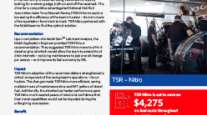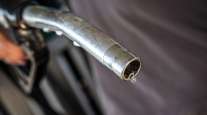Diesel Slips 1.1¢ to $2.79
This story appears in the Nov. 23 print edition of Transport Topics.
The U.S. diesel and gasoline price averages both dipped for a second week, giving back some of the strong October surge in refined product costs during the four previous weeks. Crude oil fluctuated but remained below $80 a barrel.
The Department of Energy said Nov. 16 that diesel dipped 1.1 cents a gallon to $2.79, leaving trucking’s main fuel cheaper than a year ago, but only by 1.9 cents. Prior to these two recent declines, diesel rose 22.6 cents a gallon over four weeks.
DOE’s survey also said the national average for regular gasoline slipped by 3.7 cents a gallon to $2.629. Gas also rose by 22.6 cents a gallon from Oct. 5 to Nov. 2, but the last two declines have taken back 6.5 cents. Unlike diesel, the gasoline average is higher than a year ago — by 55.7 cents a gallon.
“Refiners haven’t been able to rely on improvements in demand, so they’ve cut back on supply . . . but the supply cuts haven’t really eaten into inventories,” said Ben Brockwell, director of data, pricing and information services for the Oil Price Information Service in Wall, N.J. DOE’s Energy Information Administration said refinery utilization was 79.4% as of Nov. 13, whereas a year ago it was 84.9%.
Crude oil futures contracts on the New York Mercantile Exchange closed at $77.46 a barrel on Nov. 19, remaining within the $76.30-to-$81.40 range, as they have since Oct. 15.
Inventories of crude, diesel and gasoline all declined from Nov. 6-13, but remained well above their year-ago levels. The declines in stock levels were attributed more to lax refinery production than growing demand, as refinery utilization remained just below 80% and distillate production levels remained weak.
Brockwell said utilization of less than 80% is “like what you see after a hurricane.”
“Even with refineries running at less than 80% of capacity, distillate stocks were unable to post more than a token decline,” Tim Evans, an energy analyst with Citi Futures Perspective in New York, told Bloomberg News. “Demand must be terrible,” Evans said.
Managers at refrigerated carrier Navajo Express, Denver, are working toward 7 miles per gallon efficiency and assuming that $3-a-gallon prices will return in coming months, said President Don Digby Jr.
“We’ve talked to our fuel providers, and you just have to assume it will be going up, so you have to save a quarter of a penny here and a quarter of a penny there,” Digby said of his 1,000-truck fleet.
“We’ve governed our trucks at 62 mph, urged drivers to use cruise control, and we’re trying to keep our ‘deadhead’ miles at less than 10%,” he said.
Digby praised most of his customers, calling them “carrier friendly,” for paying fuel surcharges on both tractor and reefer-unit fuel. But even during a slow economy, the company has to steer away from loads where the fee does not cover expenses, he added.
“We try to stay away from flat-rate loads. We expect to be paid a fuel surcharge for both,” Digby said of his meat-hauling operations, when he has to run a tractor and the trailer reefer unit to haul food properly.
Flatbed carrier Davis Transport, Missoula, Mont., has devised a fuel surcharge matrix to pay owner-operators, said CEO Bob Roullier.
When freight brokers and third-party logistics providers tender flat-rate loads without a surcharge, the program uses diesel price and length-of-haul information to impute a surcharge value.
“Owner-operators live and die on fuel prices. This costs us something, but we have to do it,” Roullier said. Maintaining good relations with drivers is especially important, he said, because while there is a good pool of drivers now, if the economy were to heat up at some point, he expects there would be a shortage of trucks.
“If we were actually really busy, the current pool of drivers couldn’t support that,” he said.
Roullier said he is pleased Davis has remained profitable during the recession, but considering that the economy is still weak and not in a strong recovery, he does not expect crude oil or diesel prices to surge anytime soon.
“Until the global economy heats up, I don’t think there will be any big increases over $75 to $85 a barrel for oil,” he said.
Given current economic conditions, OPIS’ Brockwell said he does think there is room for oil prices to proceed with a sustained increase past the $80 level. He also sees demand for diesel fuel stuck at a low level.
“I don’t know if the oil market has the legs to go much higher than $80 now. It might even be overvalued at that level,” Brockwell said.




